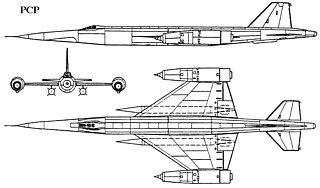
The Tupolev Tu-144 is a Soviet supersonic passenger airliner designed by Tupolev in operation from 1968 to 1999.

The Tupolev Tu-85 was a Soviet prototype strategic bomber based on the Tu-4, an unlicensed reverse engineered copy of the Boeing B-29 Superfortress. It was the ultimate development of the B-29 family, being over 50% heavier than its progenitor and had nearly double the range. Only two prototypes were built before the program was cancelled in favor of the Tupolev Tu-95 bomber which was much faster and had the same range.
The Tupolev Tu-70 was a Soviet passenger variant of the Tu-4 bomber and designed immediately after the end of World War II. It used a number of components from Boeing B-29s that had made emergency landings in the Soviet Union after bombing Japan. It had the first pressurized fuselage in the Soviet Union and first flew on 27 November 1946. The aircraft was successfully tested, recommended for serial production, but ultimately not produced because of more pressing military orders and because Aeroflot had no requirement for such an aircraft.

Tupolev, officially Joint Stock Company Tupolev, is a Russian aerospace and defence company headquartered in Basmanny District, Moscow.

The Tupolev Tu-22 was the first supersonic bomber to enter production in the Soviet Union and the world's first aircraft of its class. Manufactured by Tupolev, the Tu-22 entered service with the Soviet military in the 1960s. The last examples were retired during the early 2000s. Produced in comparatively small numbers, the aircraft was a disappointment, lacking the intercontinental range that had been expected. Later in their service life, Tu-22s were used as launch platforms for the Soviet Kh-22 standoff missile, and as reconnaissance aircraft. Tu-22s were sold to other nations, including Libya and Iraq. The Tu-22 was one of the few Soviet bombers to see combat; Libyan Tu-22s were used against Tanzania and Chad, and Iraqi Tu-22s were used during the Iran–Iraq War.

The Myasishchev M-4 Molot was a four-engined strategic bomber designed by Vladimir Mikhailovich Myasishchev and manufactured by the Soviet Union in the 1950s to provide a Long Range Aviation bomber capable of attacking targets in North America.

The Tupolev Tu-22M is a supersonic, variable-sweep wing, long-range strategic and maritime strike bomber developed by the Tupolev Design Bureau in the 1960s. According to some sources, the bomber was believed to be designated Tu-26 at one time. During the Cold War, the Tu-22M was operated by the Soviet Air Forces (VVS) in a missile carrier strategic bombing role, and by the Soviet Naval Aviation in a long-range maritime anti-shipping role. Significant numbers remain in service with the Russian Air Force, and as of 2014 more than 100 Tu-22Ms are in use.

The Kh-55 is a Soviet/Russian subsonic air-launched cruise missile, designed by MKB Raduga. It has a range of up to 2,500 km (1,350 nmi) and can carry nuclear warheads. Kh-55 is launched exclusively from bomber aircraft and has spawned a number of conventionally armed variants mainly for tactical use, such as the Kh-65SE and Kh-SD, but only the Kh-101 and Kh-555 appear to have made it into service. Contrary to popular belief, the Kh-55 was not the basis of the submarine- and ground-launched S-10 Granat or RK-55 Relief designed by NPO Novator. The RK-55 is very similar to the air-launched Kh-55 but the Kh-55 has a drop-down turbofan engine and was designed by MKB Raduga. Both have formed the basis of post-Cold-War missiles, in particular the Sizzler which has a supersonic approach phase.
The Kh-22 is a large, long-range anti-ship missile developed by MKB Raduga in the Soviet Union. It was intended for use against US Navy aircraft carriers and carrier battle groups, with either a conventional or nuclear warhead.
The Tupolev Tu-125 was an unrealized project to develop a new long-range supersonic bomber for the Soviet Air Force. Development commenced in 1958 to replace the newest Tu-22. The "Tu-125" designation was an internal one used by the Tupolev design bureau. Since the aircraft was never built, it never received a military designation.

The Myasishchev M-50 is a Soviet prototype four-jet engine supersonic strategic bomber which never attained service. Only one flightworthy prototype was built, which was first flown in October 1959. The M-50 was constructed by the Myasishchev design bureau.

The Tupolev Tu-95LAL,, was an experimental aircraft that was a modified Tupolev Tu-95 Soviet bomber aircraft, which flew from 1961 to 1965, analogous to the United States' earlier Convair NB-36H. It was intended to see whether a nuclear reactor could be used to power an aircraft, primarily testing airborne operation of a reactor and shielding for components and crew.

The Tsybin RSR was a Soviet design for an advanced, long-range, Mach 3 strategic reconnaissance aircraft.

The Tupolev Tu-141 Strizh is a Soviet reconnaissance drone that served with the Soviet Red Army during the late 1970s and 1980s.

The Raduga KSR-5 was a long-range, air-launched cruise missile and anti ship missile developed by the Soviet Union. It was essentially a scaled down version of the Kh-22 'Kitchen', built to be carried by the less capable Tu-16.

The Tupolev Tu-244 was a proposed supersonic transport (SST) aircraft, developed from the Tu-144. It implemented novel features such as cryogenic fuel to enable flight distances of up to 10.000 km (6.214 mi) and would have carried up to 300 passengers. The project was cancelled in 1993.
The Tupolev Tu-82 was a 1940s Soviet experimental swept-wing bomber. It was the first Soviet jet bomber with swept wings.
This is a Glossary of acronyms used for aircraft designations in the Russian federation and formerly the USSR. The Latin-alphabet names are phonetic representations of the Cyrillic originals, and variations are inevitable.

The Tupolev '73',, was a Soviet trijet medium bomber of the late 1940s. It lost out to the Ilyushin Il-28 'Beagle'.
The Tupolev Voron was a planned supersonic unmanned reconnaissance aircraft of the Soviet Union manufactured by the company Tupolev, largely based on or designed to compete with the Lockheed D-21.













